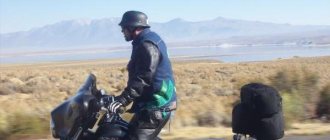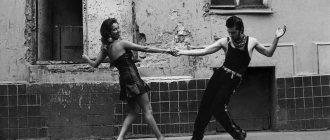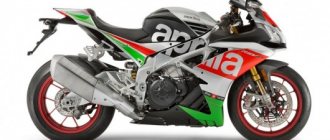Motorcycle clubs in Russia: addresses, passwords, appearances
The history of motorcycle clubs originates in the USA. It was there that motorcyclists, in search of like-minded people, began to gather in garages and plow the endless roads of the United States on oiled “iron horses.” The first Yonkers MC club was created at the beginning of the last century - in 1903. A year later, in the same image and likeness, enthusiasts organized another one - San Francisco MC. The third legendary association is considered to be Oakland MC. It appeared later - in 1907.
The image of bikers committing crime appeared for a reason. Previously, they really staged drunken brawls in bars and frightened ordinary Americans with their appearance. The age of such leisure ended with the creation of the American Motorcycle Association. The president of the organization, honestly chosen by the bikers, said that the association would put an end to criminal behavior and make the movement safe for ordinary people. The rowdies were expelled from the association, and since then the motorcycle clubs have led a more or less quiet lifestyle.
Image mage by Hans Braxmeier from Pixabay
Today there are many motorcycle clubs scattered around the world. The most famous are 4 associations that bikers call among themselves the “Big Four”: “Hells Angels”, Outlaw MC, Pagans MC and Bandidos MC. By the way, their branches are also in Russia.
Over time, associations developed their own structure, set of rules, symbols and terminology. Clubs take this very seriously. For motorcyclists, this is not just an association; relationships in such communities are more like brotherhood. Therefore, failure to comply with the rules, for example, can lead to expulsion from the club.
How motorcycle clubs appeared in Russia
Photo: unsplash.com
It took almost a hundred years for motorcycle clubs to reach Russia. Because of the Iron Curtain, information about them practically did not reach Soviet citizens. It was possible to see bikers uniting in action films, but this was still not enough to create a full-fledged movement. The first motorcycle club can be called Cossacks MC Russia. It appeared in 1989, and was created by the legend of the motorcycle world Oleg Goch. He spotted the idea in Copenhagen. As the biker said in one of his interviews, his friends dragged him to the Hells Angels clubhouse.
“My jaw dropped! Old school choppers, real bikers, all in a themed setting. We haven't even seen this in pictures! I didn’t leave there for three days, it was there that I learned about MC clubs, about “flowers”. There, the tattoo artist drew our future emblem. I was the first Soviet biker to join the HAMC structure,” said Oleg Goch
What motorcycle clubs are there in Russia?
There are a great many motorcycle clubs in the vastness of Russia. In almost all cities of the country you can find a community of fans of “iron” horses. We decided to study the largest of them.
Bandidos MC Russia
Where : Moscow
Branch of the world famous and oldest motorcycle club. Races and parties are held there regularly. The event program can be found on the official website of the motorcycle club.
Leaving into the night MCC
Where : Moscow, Krasnodar, Aprelevka
One of the oldest motorcycle clubs in Russia. Bikers regularly get together at car rallies and events.
“Our association is based on the unshakable eternal postulates of the Men's Brotherhood. The basis of our relationship is respect and recognition of a comrade as an individual,” says the club’s official website.
Legion MC
Where : St. Petersburg
The motorcycle club, created in 1999, still exists and is active.
“In order to become a member of the club, you need to have a desire, a motorcycle and meet certain club criteria. But staying with them in the future is even more difficult, because you need to give a part of yourself, and not just visit a company of interests,” says the movement’s website.
In 2006, club representatives built a full-fledged Club house, where the community is based to this day.
Black knives
Where : Ekaterinburg
The motorcycle club opened on March 23, 2002. Over the years of its existence, it has become widely known in Yekaterinburg, the Ural region and beyond as a democratic organization of motorcycle sports and tourism lovers.
“One of the goals of the motorcycle club is to support Russian patriotic traditions based on the continuity of generations, love for one’s country and city,” the club says on its social networks.
Night Wolves
Where : there are branches of the club in many cities of Russia; the full list can be found on the website.
“Night Wolves” is the second oldest Russian motorcycle club, which still exists in Russia as a public non-profit organization “Russian Motorcyclists” registered in 1995. Has a Bike Center in Nizhniye Mnevniki in Moscow. He is a member of the Russian Bikers Association.
hell's Angels
Where : Moscow
One of the oldest and largest motorcycle clubs in the world. Its branches (so-called “chapters”) are scattered throughout the world. It is one of the “big four” outlaw clubs and is the most famous among them.
Free Brothers MC
Where : Saratov, Moscow
The history of the club began in 2003. He appeared in opposition to another motorcycle club, which had strict rules and restrictions. Now the community is organizing various events and doing its best to promote the development of the biker movement.
Motor Brotherhood M.C.C.
Where : Klintsy (Moscow region)
“The United Motorcycle Club “Motor Brotherhood” was created on the basis of the amateur Sports and Technical Club “MOTO-X” in Klintsy, formed in 1999. The purpose of creating the Club was to unite everyone who preferred to move on two wheels, be it sports or recreation, which determined the name of the Club,” the club’s official website reports.
Dobermans MCC
Where : Moscow
A relatively young motorcycle club was founded by like-minded people in 2021. Its participants actively conduct motorcycle seasons in the Moscow region.
“If you have a desire to join our Club, you should remember that your social status or the cost of your motorcycle is absolutely not important to us, but it is important to us that you have a desire to support and develop the Club, so that there is that very spirit of freedom that draws you to a path towards freedom and adventure,” say the creators.
© Online magazine “Global City” Polina Popova
Bandidos Motorcycle Club
The Bandidos were founded in 1966 by 36-year-old dock worker Donald Eugene Chambers in San Leon, Texas. He named the club after Mexican gangsters who lived by their own rules, and he recruited his first like-minded people from biker bars in Houston, Corpus Christi, Galveston and San Antonio. By the early 1970s, the club already had more than a hundred members, including many Vietnam War veterans.
Today, Bandidos has nearly 100 affiliates in the United States, 90 in Europe, 17 in Australia, 2 in New Zealand, Southeast Asia and the Middle East.
Club members often became involved in high-profile criminal cases related to contract killings, racketeering, drug trafficking and weapons sales.
On August 16, 2004, Richard Merla, then a member of the Bandidos, fatally stabbed super lightweight boxing champion Robert Quiroga during a card game and altercation. For this crime he received 40 years in prison, and he was also expelled from the ranks of the Bandidos.
Mongols Motorcycle Club
The club has a long history of drug trafficking (especially methamphetamine), money laundering, robbery, extortion, firearms violations, murder and assault. To expose its participants, a real special operation was organized: in 1998, ATF agent William Queen infiltrated the club as an ordinary member, but was able to rise in the local “hierarchy” to the rank of vice president of the branch. In April 2000, based on evidence collected during a 28-month undercover stint, 54 club members were arrested. All but one of the defendants were subsequently convicted of various crimes, including drug trafficking, motorcycle theft and conspiracy to commit murder.
But even despite the evidence, one of the club's presidents, David Santillan, denies that the organization was ever a criminal enterprise, and lawyers claim that the Mongols even changed their code of conduct to exclude drug addicts and those with criminal records.
Rock Machine
This international motorcycle club was formed in 1986 by Salvatore Cazzetta, a former friend of the president of the Hells Angels in Quebec. The new organization entered into a struggle with the Hells Angels for influence in the criminal world, and, most importantly, for dominance in the street drug trade. The conflict turned out to be bloody and protracted, and was even called the “Quebec Biker War”: between 1994 and 2002, more than 160 people were killed and hundreds were injured.
Rock Machine has a record of drug and weapons trafficking, extortion, prostitution, money laundering, armed robbery, murder, assault and kidnapping, despite the fact that the authorities tried to actively fight the bikers. In addition, gang members are racists and do not accept “colored” people into their ranks.
In the 2000s, the club began to lose popularity and power and was gradually disbanded, but former members of the Mongols and Bandidos reformed Rock Machine in 2007. Members of the latest incarnation of the Rock Machine claim that it is simply a motorcycle club that has nothing to do with criminal activity.
Pagan's Motorcycle Club
Pagan's Motorcycle Club, or simply Pagans, is an outlaw motorcycle club created by Lou Dobkin in 1959 in Prince George's County, Maryland. The Federal Bureau of Investigation classifies the Pagans as a criminal gang that constantly wages turf wars with other motorcycle clubs. They are active along the east coast of the United States, especially in Florida, Kentucky, New Jersey, Ohio, Pennsylvania, Massachusetts and Puerto Rico.
Active criminal activity began in the late 60s and intensified after John Marron, nicknamed “Satan,” became the head of the club. The top echelon of Pagans management must always consist of 13 members.
Pagans are associated with the production and smuggling of drugs such as methamphetamine, marijuana, cocaine and heroin. They are also noted for their close ties to organized crime, especially in New Jersey and Pennsylvania. Pagans has a record of involvement in attacks, arson, extortion, motorcycle and car thefts, and arms trafficking.
Recently, the club's membership has begun to grow: more than 1,300 members and about a hundred chapters are active along the east coast of the United States.











